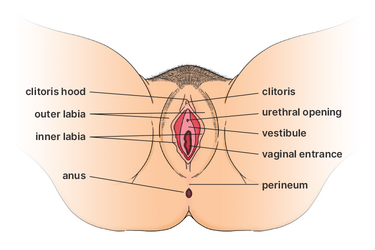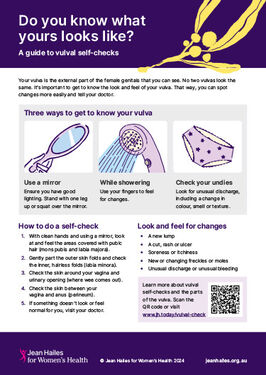It’s important to look after your vulva and vagina and understand what’s normal for you. Learn more about this area of your body and how to take good care of it.
Some people think the vulva is the vagina, but they are different. Your vulva is the external part of the female genitals that you can see. Your vagina is inside your body. It extends from your vulva to the start of your uterus. It’s where your period flows down from the uterus, where you can have sexual intercourse (or other types of penetration) and where babies pass through during childbirth.
Your vulva includes:
The below picture shows different parts of the vulva.

Each woman’s vulva is unique in size, shape, colour and appearance. It’s normal for the left and right sides of the vulva to be different in shape and size, especially the labia minora. Many images you see online are heavily edited to make the vulva look symmetrical and childlike.
It’s a good idea to see what your vulva looks like. You can use a mirror to see what is normal for you. This will make it easier to detect any changes in appearance, for example, changes in colour or skin. The Labia Library is a great online resource that shows a range of ‘normal’ photos of labia.
It’s normal for your vulva and vagina to smell different at different times in your menstrual cycle and after menopause.
There are many fluids and secretions associated with the vulva that can affect the smell. For example, urine, sweat, menstrual blood, skin oils and vaginal and gland secretions.
If the smell is unpleasant, yeasty or fishy smelling, this may be a sign of an infection. An unpleasant smell may also be due to a sexually transmitted infection (STI), a tampon that needs to be changed, or not wiping thoroughly after going to the toilet.
After menopause, the smell may be different to when you were having periods because the bacteria in your vagina changes at this time.
If you are worried about the smell, or have symptoms such as itching, burning, irritation, soreness, painful sex or pain when you wee, see your doctor.
After menopause, hormonal changes can make the vulva and vagina feel dry. At this time, you may have a loss of natural lubrication, which can cause pain or discomfort with vaginal penetration (e.g. vaginal sex).
There are many things you can do to look after your vulva and avoid vulval irritation.
Use soap-free products or just water to wash your vulva. Avoid using perfumed soaps and bath products, douches or vaginal washes as these may irritate your vulva.
Never use talcum powder on your vulva, as it can cause inflammation.
Wear natural fibre underwear (cotton and bamboo) rather than synthetic. And wash your underwear in pure or unscented soap.
Avoid tight-fitting jeans and pants. And if you wear pantyhose, make sure they have a cotton gusset.
After exercise, change or shower straight away. Lycra and sweat can irritate your vulva.
If you swim in chlorinated water, you can use a barrier ointment to avoid vulval irritation. These ointments are available in most chemists and supermarkets.
After swimming, try to shower straight away. This will remove any chlorine or salt from your vulva.
After you go to the toilet, wipe or pat your vulva from front to back. And try to use white, unscented toilet paper.
Use 100% cotton sanitary pads and tampons – and change them regularly. If your menstrual blood irritates your vulva, you can use tampons or a menstrual cup instead of pads.
If required, use silicone or water-based lubricants when you have vaginal sex. You can also use good-quality natural oils, such as olive or almond oil. But don’t use oils or silicone lubricants with condoms, as they damage the latex – causing the condom to break.

Do you know what yours looks like?
This web page is designed to be informative and educational. It is not intended to provide specific medical advice or replace advice from your health practitioner. The information above is based on current medical knowledge, evidence and practice as at April 2023.
This content has been reviewed by a group of medical subject matter experts, in accordance with Jean Hailes policy.
© Jean Hailes Foundation. All rights reserved.